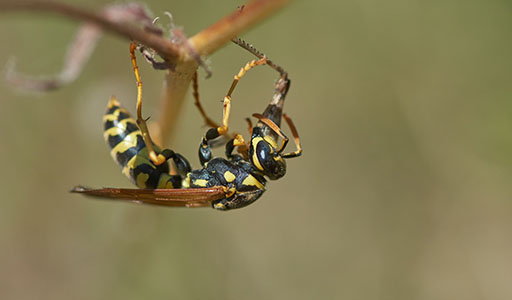Wasps

Wasp Information
With over 30,000 species worldwide, wasps are incredibly diverse insects. However, the most common U.S. varieties have a few things in common. Bright warning colors, painful stings, and attraction to sweets can all describe the paper wasp, yellow jacket, bald-faced hornet, and European hornet. Nesting underground, in trees, on buildings, and even inside houses, these pests can be both a nuisance and a danger to homeowners.

What does a Wasp look like?
Distinguished from bees by their pointed abdomens and narrow waists, wasps can also come in colors from brown and black to electric yellow, metallic blue, and bright red. Brighter colored wasps, like yellow jackets, are usually more aggressive, while those with muted colors, like mud daubers, rarely sting. Unlike honey bees, most species of wasps have stingers that do not detach after one use, allowing them to attack multiple times when threatened.

What does a Wasp eat?
Wasps are omnivores, feeding on spiders, flies, crickets, and other insect pests as well as nectar, fruit, and honeydew. In general, young wasps need more protein to survive than adults, who tend to stick to plant materials. Picnics and outdoor gatherings in late summer and fall may be visited by these scavenging pests, which are also attracted to sugary drinks and human food scraps.

Wasp habitats
The pests’ presence and species can often by identified by their nests. Yellow jackets, paper wasps, and hornets all construct nests by chewing wood into a moldable, papery pulp. However, while hornets and paper wasps build in elevated places, such as tree limbs, attics, or the eaves and roofs of homes, yellow jackets prefer old animal burrows and other underground cavities. Mud daubers get their name from their mud nests, which consist of several, individual tubes.


